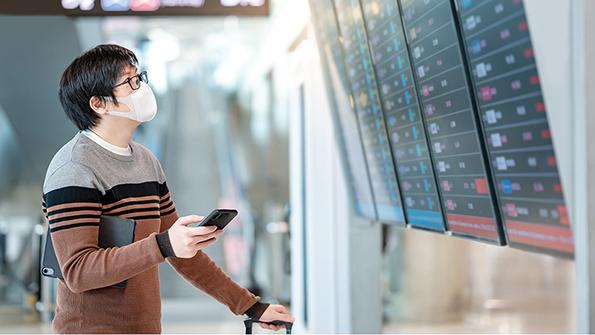As airports grapple with the immediate financial crisis of an unprecedented decline in air travelers caused by pandemic restrictions, they are also looking ahead to the “new normal” when passengers eventually return.
But those returning travelers are likely to have different expectations in the post-pandemic world, according to one expert, and airports will need to rethink how they use their physical and digital infrastructures to accommodate them.
“There are so many new hurdles traveling in the COVID-19 era. Anybody who thinks they know the answer exactly doesn’t really know what they are talking about because consumer behaviors have and will change dramatically,” EPAM Continuum director of innovation consulting and travel & hospitality lead Dustin Boutet told ATW.
“It might not be for the long term, but I’d say that over the next two to three years we’re going to see a different type of traveler. There will be different behaviors when they are traveling, and they will have different needs from the airport infrastructure.”

Traveling will be a more stressful experience as passengers weigh health and safety risks with the need to fly.
“One of the things air travel does is stress you out, so I think there’s a real opportunity for airports to create those experiences to reduce that stress,” Boutet said.
For example, instead of packing people into retail and dining establishments while waiting for flights, he believes airports need to offer a blend of amenities that include outdoor space where passengers can be more physically distanced to augment the other offerings.
“People who are in the mindset of stress-free travel are more likely to engage with retail and dining experiences,” he said.
Going forward, airports need to create more flexible and adaptable spaces “so you can space people out and allow better use of the square footage you have,” he said. “Some airports are massive. For example, the new airport in Daxing, China, is 7.5 million sq. ft., which is plenty of space for people to be socially distant and travel safely. We just need to think creatively about how to utilize that space.”
Turning to airport revenue streams, he believes airports need to scrap the sales-per-square-foot metric and instead think about creative ways to blend physical and digital experiences.
Airports must consider how digital infrastructure can be leveraged to give passengers the ability to know when to arrive and how to navigate through the airport, Boutet said. If they need food, they should also know where they can pick it up in a contactless way. If they need to shop, how can it be a safe, physically distanced experience?
“One approach is to make the space just a showroom,” he said. “And if you flip that on its head, another interesting thing you can think about is that those spaces are just pickup points, as you’ve already done the digital showrooming. You might have purchased your product online, but if there is an easy way to pick up the merchandise on your way, that seems like a really good area of exploration for some of our retailers.”
SMART SIGNS
In 2017, EPAM developed a digital wayfinding design and prototype system for Southwest Airlines to help guide its customers through the airport. The system addressed three challenges: lack of clear and accurate information, excessive gate crowding and the need for more meaningful customer service. The system was tested at Dallas Love Field Airport.
“Based on customer and employee feedback, we redesigned all of the existing airport signage and added new sign types at key locations throughout the airport,” Boutet said. “Each sign in the new system was fully digital and location-aware, so that we could tailor each sign based on time of day, flight status and customer needs.”
“Providing passengers with better, more personalized information through signage, apps and online experiences helped to reduce that congestion, which in turn reduces stress,” he said. “With today’s low load factors, you could use a system like this to reduce congestion even more. Then, once you’ve got people onboard the aircraft, I think you can do staggered arrivals and start to understand when there’s going to be huge crowds, and with a bigger data set like that we can start to be even smarter about scheduling flights. There’s a lot of data out there about passengers and the way they move through the airport. But applying that intelligently, especially with a reduced flight schedule, I think will enable us to do better scheduling and crowd management.”
Health and Safety
Airports also have an opportunity to take a fresh look at health and security screening in an effort to find new ways to reduce pinch points and passenger stress.
“The need for security screening is not going to go away, but airports are going to think creatively about that screening,” Boutet said. “Does it all need to happen in one very distinct location? Do we have the ability to outsource some of that screening as we have done with solutions like [US Transportation Security Administration’s] CLEAR, where some background information is done ahead of time?”
He said some airports are already introducing some novel ways to tackle the health challenge, such as testing upon arrival or just a simple health screening questionnaire.
“I don’t think we’ve cracked the code, for sure, and I don’t think there is a silver bullet to screening. I think it is layering on different techniques and approaches to create a better job of screening,” he said.
One key to cracking the code would be government standards and regulations for screening and contact tracing.
“Until we have a standardized, regulated approach, we are going to get this hodgepodge of mish-mashed solutions that don’t really fit together, that don’t have any kind of broader accountability in how they’re tracing and applying some of these technologies,” Boutet said. “That concerns me, because it is different from airport to airport, from airline to airline. And there’s an opportunity for a lot to fall in between the cracks. A lot of airlines are instituting what they can and taking the best approaches they can within their current business constraints and applying them, but without a concerted effort from our regulators, we will not get a solution that will stick.”


